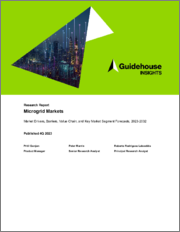Microgrid Markets: Market Drivers, Barriers, Value Chain, and Key Market Segment Forecasts, 2023-2032
소매 전기 요금이 상승하고, 분산형 에너지 자원의 비용이 계속 하락하고, 계통 중단을 유발하는 불리한 사건(자연재해 등)의 빈도가 증가함에 따라 모든 비지니스 부문의 고객이 마이크로 그리드의 이점을 평가하고 있습니다.
탈탄소화 활동으로 인해 재생에너지 발전과 에너지 저장을 화석연료 백업 발전기와 함께 활용하는 마이크로그리드가 주목받고 있으며, 이 모든 것은 전력회사의 송전망과 연계하거나 송전망과 분리하여 자산을 운영할 수 있는 국지적 제어 시스템에 의해 관리되고 있습니다. 동시에 탄력성 및 자동화 추세는 강화된 백업 솔루션을 제공하는 스마트 발전기 세트 기반 마이크로그리드 시장을 창출하고 있으며, 그리드에 대한 지원도 점점 더 많아지고 있습니다. 통합업체와 개발업체들은 호스트와 개발업체의 대차대조표에서 자금을 조달하지 않는 프로젝트에 대해 소비자에게 혁신적인 융자 메커니즘을 제공하는 데도 주력하고 있습니다. 이는 시스템 소유와 운영을 통합업체나 개발자에게 위탁하는 EaaS(Energy as a Service) 형태의 계약을 통해 개발자가 선투자 없이도 소비자에게 솔루션을 제공할 수 있도록 합니다.
이 보고서는 세계 마이크로그리드 시장을 조사 분석하여 2032년까지 모든 주요 마이크로그리드 부문에 대한 배포 및 지출을 포함한 시장 잠재력을 예측합니다.
목차
제1장 주요 요약
제2장 시장 문제
- 시장 성장 촉진요인
- 에너지 저장 시스템 비용 저하
- 제어·관리 기술 혁신
- 마이크로그리드의 사회경제적 이점
- 모듈형/컨테이너화 마이크로그리드 솔루션의 대두
- 스마트 발전기 마이크로그리드의 증가
- 진화하는 마이크로그리드 금융
- 시장 장벽
- 리질리언스의 가치에 관한 컨센서스 결여
- 컨트롤러의 비용, 성능, 호환성
- 마이크로그리드 선택에 관한 과제
- 합리화된 상호접속 프로세스의 결여
- 지역 분석
- 북미
- 유럽
- 아시아태평양
- 라틴아메리카
- 중동 및 아프리카
제3장 산업 밸류체인
- 밸류체인 개요
- 컴포넌트 제조업체
- 컨트롤 프로바이더
- 개발자
- 시스템 통합사업자
- 엔지니어링, 조달, 건설
- 운영, 보수
- 경쟁 상황
- 마이크로그리드 인티그레이터
- 비지니스 모델의 진화
제4장 시장 예측
- 예측 방법
- 세계 시장 개요
- 주요 마이크로그리드 용도 부문
- 상업용 및 산업용 마이크로그리드
- 커뮤니티용 마이크로그리드
- 캠퍼스/기관용 마이크로그리드
- 원격 마이크로그리드
- 유틸리티 배전 마이크로그리드
- 마이크로그리드 비지니스 모델
제5장 결론, 추천사항
- 3개 주요 포인트
- 추천사항
- 마이크로그리드 개발자
- 정부와 금융기관
- 전력 기업과 그리드 사업자
- 최종사용자
제6장 두문자어와 약어 리스트
제7장 목차
제8장 도표
제9장 조사 범위
제10장 정보 출처, 조사 방법, 주석
ksm
Customers in all business segments are increasingly evaluating the benefits of microgrids as retail electricity rates rise, costs for distributed energy resources continue to decline, and adverse events causing grid outages (e.g., natural disasters) increase in frequency.
Decarbonization efforts have created a focus on microgrids that leverage renewable energy generation plus energy storage with a fossil fuel backup generator, all managed by a localized control system capable of operating the assets in concert with or islanded from the utility grid. At the same time, resilience and automation trends have created a market for smart genset-based microgrids that provide enhanced backup solutions and, increasingly, support to the grid. Integrators and developers are also focused on offering innovative financing mechanisms to consumers for projects that are not financed through the host's or developer's balance sheet. This can allow developers to offer their solutions with no upfront capital requirement for the consumer via an energy as a service (EaaS) type contract in which system ownership and operation are outsourced to the integrator or developer.
This Guidehouse Insights report forecasts market potential, including deployments and spending, for all major microgrid segments (commercial and industrial, community, campus/institutional, stationary military base, remote, and utility distribution microgrids) over a 10-year forecast period through 2032. Forecasts are broken down by global region (North America, Europe, Asia Pacific, Latin America, and the Middle East & Africa) as well as business model (EaaS, government, owner financing, utility rate base, and other).
Table of Contents
1. Executive Summary
- 1.1 Microgrid Definition
- 1.2 Market Trends
- 1.3 Global Outlook
2. Market Issues
- 2.1 Market Drivers
- 2.1.1 Falling Costs for Energy Storage Systems
- 2.1.2 Innovations in Control and Management Technologies
- 2.1.3 Socioeconomic Benefits of Microgrids
- 2.1.4 Rise of Modular/Containerized Microgrid Solutions
- 2.1.4.1 Schneider Electric Case Study
- 2.1.5 Increase in Smart Genset Microgrids
- 2.1.5.1 Enchanted Rock Case Study
- 2.1.6 Evolving Microgrid Financing
- 2.2 Market Barriers
- 2.2.1 Lack of Consensus around the Value of Resilience
- 2.2.2 Controller Costs, Performance, and Compatibility
- 2.2.3 Challenges Related to the Selection of Microgrids
- 2.2.4 Lack of Streamlined Interconnection Processes
- 2.3 Regional Analysis
- 2.3.1 North America
- 2.3.2 Europe
- 2.3.3 Asia Pacific
- 2.3.4 Latin America
- 2.3.5 Middle East & Africa
3. Industry Value Chain
- 3.1 Value Chain Overview
- 3.1.1 Component Manufacturers
- 3.1.2 Controls Providers
- 3.1.3 Developers
- 3.1.4 System Integrators
- 3.1.5 Engineering, Procurement, and Construction
- 3.1.6 Operations and Maintenance
- 3.2 Competitive Landscape
- 3.2.1 Microgrid Integrators
- 3.2.1.1 Schneider Electric
- 3.2.1.2 Siemens
- 3.2.1.3 GE Vernova
- 3.2.1.4 Enchanted Rock
- 3.2.1.5 PowerSecure
- 3.2.2 Business Model Evolution
4. Market Forecasts
- 4.1 Forecast Methodology
- 4.1.1 Microgrid Capacity Estimates
- 4.1.2 Microgrid Implementation Spending Estimates
- 4.2 Global Market Overview
- 4.3 Major Microgrid Application Segments
- 4.3.1 Commercial and Industrial Microgrids
- 4.3.2 Community Microgrids
- 4.3.3 Campus/Institutional Microgrids
- 4.3.4 Remote Microgrids
- 4.3.5 Utility Distribution Microgrids
- 4.4 Microgrid Business Models
5. Conclusions and Recommendations
- 5.1 Three Major Takeaways
- 5.2 Recommendations
- 5.2.1 Microgrid Developers
- 5.2.2 Government and Financial Institutions
- 5.2.3 Power Utilities and Grid Operators
- 5.2.4 End Users
6. Acronym and Abbreviation List
7. Table of Contents
8. Table of Charts and Figures
9. Scope of Study
10. Sources, Methodology and Notes
